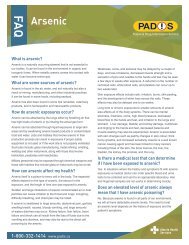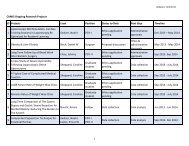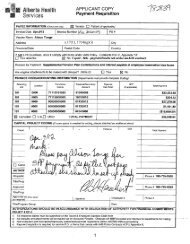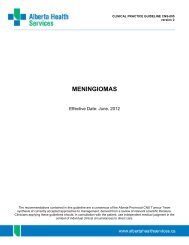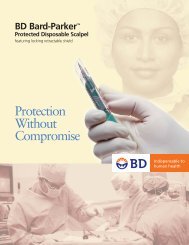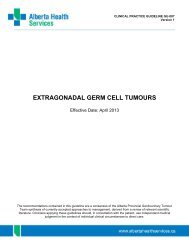taxanes in metastatic breast cancer - Alberta Health Services
taxanes in metastatic breast cancer - Alberta Health Services
taxanes in metastatic breast cancer - Alberta Health Services
You also want an ePaper? Increase the reach of your titles
YUMPU automatically turns print PDFs into web optimized ePapers that Google loves.
Summary statement<br />
CLINICAL PRACTICE GUIDELINE BR-001<br />
The CCO recommendation for docetaxel + capecitab<strong>in</strong>e was adapted. More recent evidence for docetaxel<br />
+ gemcitab<strong>in</strong>e and paclitaxel + gemcitab<strong>in</strong>e was considered by the current panel <strong>in</strong> order to create an<br />
updated recommendation on the role of taxane/non-anthracycl<strong>in</strong>e regimens.<br />
Recommendation # 5<br />
Recommendations from exist<strong>in</strong>g guidel<strong>in</strong>es<br />
The CCO guidel<strong>in</strong>e does not make recommendations regard<strong>in</strong>g nab-paclitaxel due to lack of data<br />
available at the time of guidel<strong>in</strong>e publication. They did however publish a report specifically<br />
on the role of<br />
nab-paclitaxel <strong>in</strong> the treatment of <strong>metastatic</strong> <strong>breast</strong> <strong>cancer</strong>. men with <strong>metastatic</strong><br />
e for s<strong>in</strong>gle agent paclitaxel could be offered nab-paclitaxel as an alternative.<br />
39 They conclude that wo<br />
<strong>breast</strong> <strong>cancer</strong> who are eligibl<br />
Specific regimens were not recommended.<br />
The updated NCCN guidel<strong>in</strong>e version 1.2010 lists nab-paclitaxel as one of the preferred<br />
chemotherapy<br />
regimens for recurrent or <strong>metastatic</strong> <strong>breast</strong> <strong>cancer</strong> at 100 mg/m on D1, 8, and 15 of a 28<br />
2 or 150 mg/m 2<br />
day cycle, or 260 mg/m 2 q3 weeks. 10<br />
The CECOG and NICE guidel<strong>in</strong>es do not address the role of nab-paclitaxel.<br />
BCCA has produced a protocol summary for palliative therapy for <strong>metastatic</strong> <strong>breast</strong> <strong>cancer</strong> us<strong>in</strong>g nab-<br />
paclitaxel at a dose of 260 mg/m or absolute<br />
2 q3 weeks <strong>in</strong> patients with an <strong>in</strong>tolerance to taxane<br />
contra<strong>in</strong>dication to steroids, or a documented ethanol allergy.<br />
Other evidence considered by this panel<br />
The recommendation for the use of nab-paclitaxel has been updated to reflect the recommendations of the<br />
<strong>Alberta</strong> <strong>Health</strong> <strong>Services</strong> Outpatient Cancer Drug Benefit Program. Nab-paclitaxel should<br />
be available for<br />
patients who have had severe acute <strong>in</strong>fusion reactions with paclitaxel or docetaxel<br />
(considered to be due<br />
to the vehicle of the <strong>taxanes</strong>), or <strong>in</strong> patients who have experienced severe toxicity<br />
from previous<br />
adm<strong>in</strong>istration, <strong>in</strong>clud<strong>in</strong>g toxicity related to both the taxane and the premedications. Without corticosteroid<br />
or antihistam<strong>in</strong>e pre-medication, nab-paclitaxel is associated with an <strong>in</strong>cidence of hypersensitivity<br />
reactions under 1%. all survival or significantly<br />
regimens, the panel<br />
40 In the absence of def<strong>in</strong>itive data show<strong>in</strong>g improved over<br />
reduced toxicities for nab-paclitaxel <strong>in</strong> comparison to any of the solvent-based taxane<br />
felt that it should not be offered as a rout<strong>in</strong>e, s<strong>in</strong>gle-agent option.<br />
One randomized phase II study has now been updated and published. [41] This study compared three nabpaclitaxel<br />
arms (300 mg/m 2 q3 weeks, 100 mg/m 2 weekly x3 q4 weeks and 150 mg/m 2 weekly x3 q4<br />
weeks) and one docetaxel arm (100 mg/m 2 q3 weeks). [41] nab-paclitaxel 150 mg/m 2 weekly showed<br />
significantly longer PFS over the docetaxel arm by both <strong>in</strong>dependent radiologist and <strong>in</strong>vestigator<br />
assessment (12.9 vs 7.5 months, and 14.6 vs 7.8 months respectively). Both 150 mg/m 2 and 100 mg/m 2<br />
demonstrated a higher ORR than docetaxel but this did not reach statistical significance. There was no<br />
statistical difference <strong>in</strong> ORR between nab-paclitaxel 300 mg/m 2 q 3 weeks versus docetaxel. The<br />
<strong>in</strong>cidence of febrile neutropenia was 1% <strong>in</strong> all three nab-paclitaxel arms and 8% <strong>in</strong> the docetaxel arm. The<br />
<strong>in</strong>cidence of sensory peripheral neuropathy was comparable <strong>in</strong> all arms but median time to improvement<br />
for grade 3 neuropathy was 19 to 22 days for the nab-paclitaxel arms and 37 days for the docetaxel arm.



